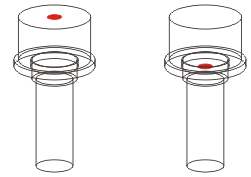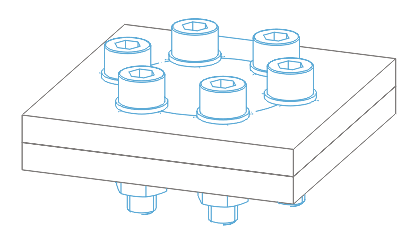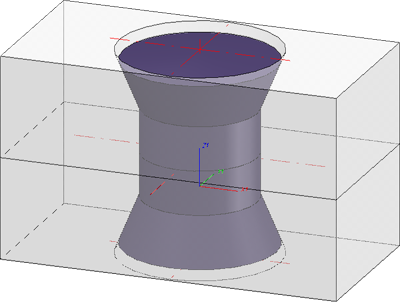
3-D Standard > Standard Parts > New bolting/riveting 
The dialogue for the insertion of boltings and rivetings begins as soon as you click OK to end one of the tabs of the Bolting dialogue window.
Now proceed as follows:
|
|
Individual fitting. The bolting/riveting is fitted perpendicularly into the processing plane opposite the z-axis. |
|
|
|
Multiple fitting, linearly arranged |
|
|
|
Multiple fitting, linearly arranged between 2 points |
|
|
|
Multiple fitting, arranged circularly in the fitting plane |

Left: Fitting point for reference plane: Upper edge, Right: Fitting point for reference plane: Countersink

Bolting on a polar grid

Riveting
 Please note:
Please note:
 function will not be ended automatically after insertion, but remains active, allowing you to insert further boltings or rivetings with the same settings (processing plane, bolting assignment, clamping length etc.). What can be modified, though, is the grid used for insertion.
function will not be ended automatically after insertion, but remains active, allowing you to insert further boltings or rivetings with the same settings (processing plane, bolting assignment, clamping length etc.). What can be modified, though, is the grid used for insertion.

If you select Yes, the bolting will be placed at the uppermost level of the part structure. You can avoid this query by activating the Uppermost level option in the Bolt assignment area of the Settings dialogue window right from the start.
|
Notes on DIN EN 14399 The tables for the bolts according to DIN EN 14399 contain a column called SET for the set identification. If a text, e.g. Set, has been entered there, the nut will not be BOM-relevant when inserting a bolting set according to DIN EN 14399. In this case, the set ID in the Article number will be considered, for the BOM e.g. Set EN 14399...... , as otherwise only the bolt would be supplied. If you clear the SET column in the Catalogue Editor, the nuts will be become BOM-relevant as well. |

Create Boltings (3-D) • Boltings and Rivetings (3-D) • Change Boltings/Rivetings (3-D)
|
© Copyright 1994-2018, ISD Software und Systeme GmbH |